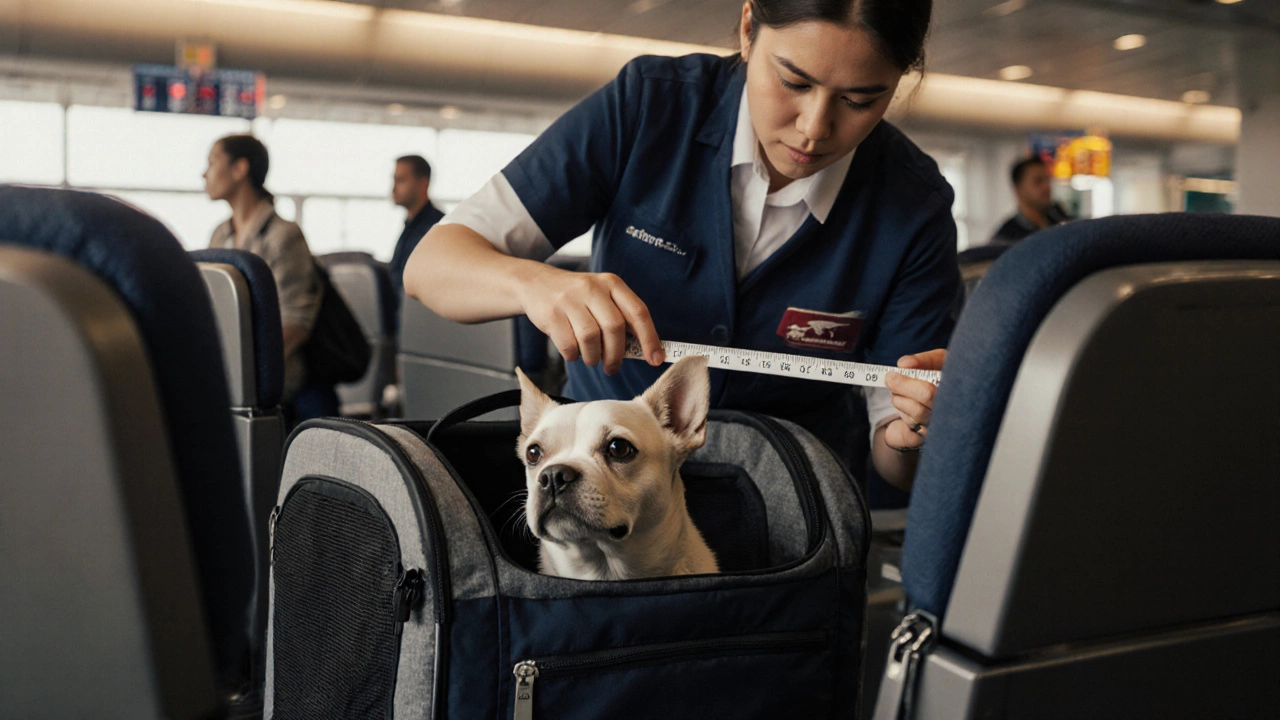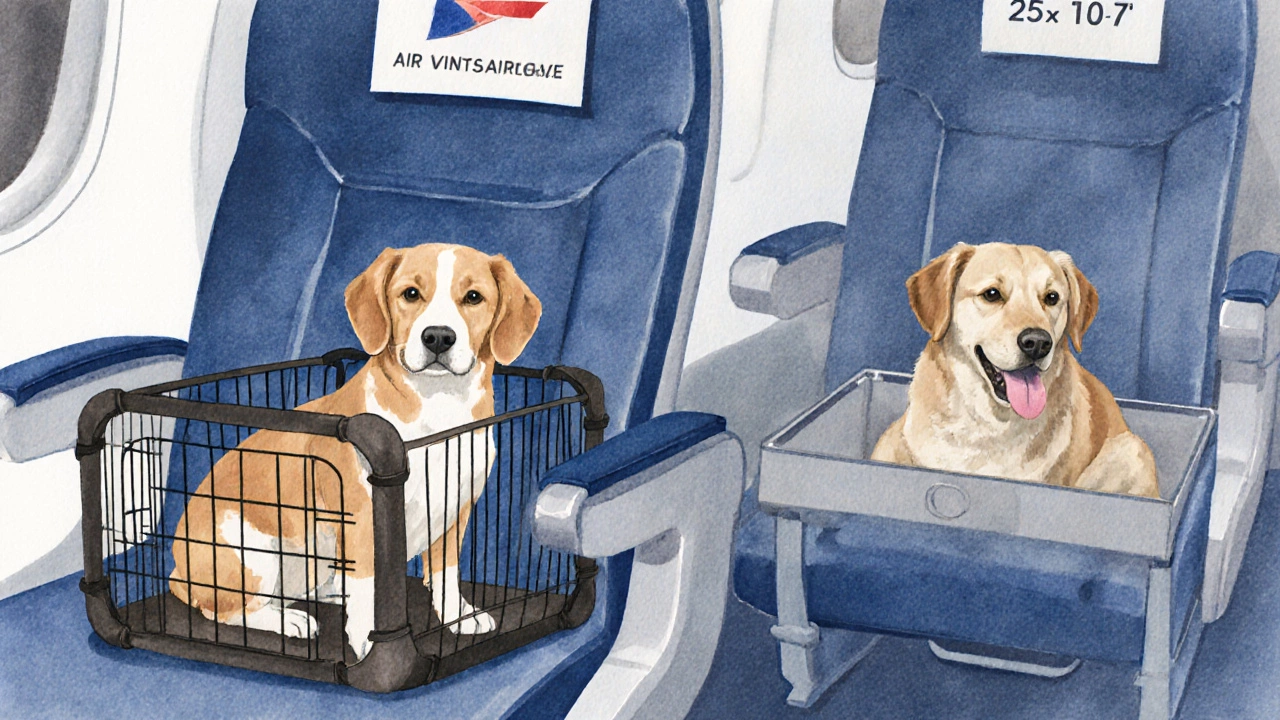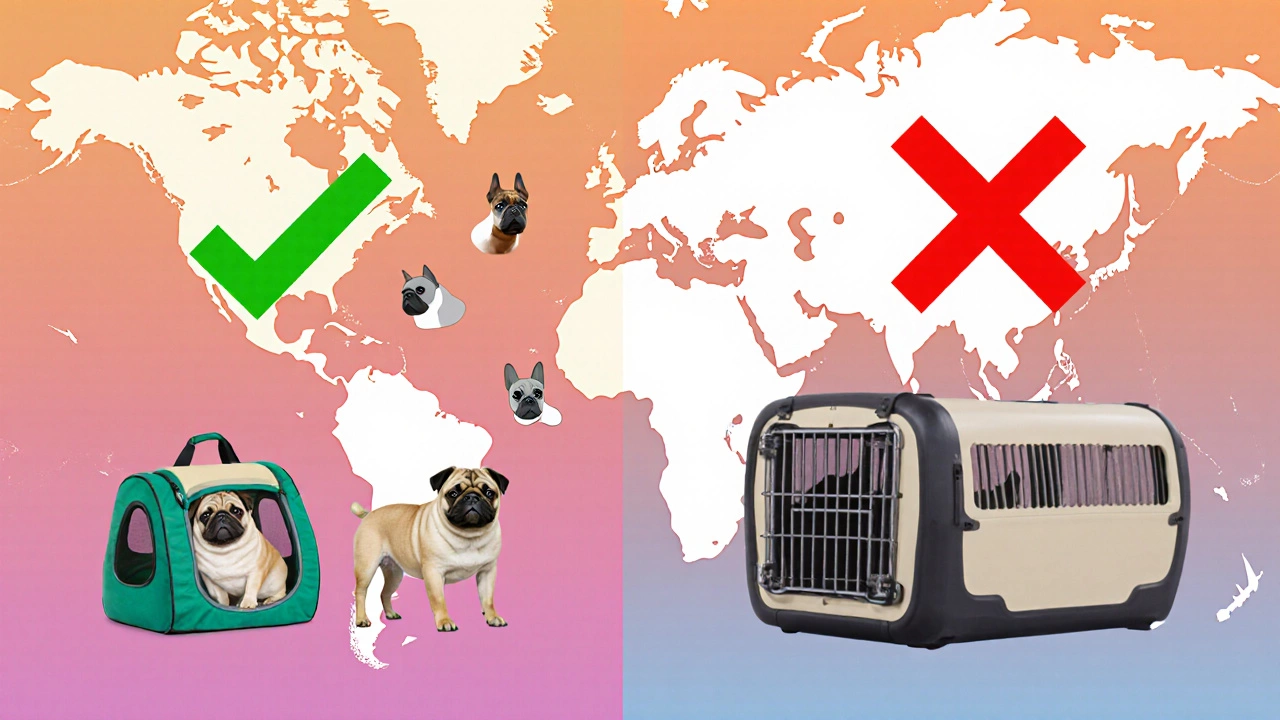
Cabin Pet Size Calculator
Check if Your Dog Can Fly in the Cabin
Enter your dog's weight, carrier details, and airline to see if you qualify for cabin travel.
Enter your information to see if your dog qualifies for cabin travel.
If you’re planning to fly with your dog, the first question you’ll ask is: What size dog can fly in the cabin? The answer isn’t simple. It’s not just about weight. It’s about the carrier, the airline, the route, and even the time of year. Many people assume if their dog is small, they’re automatically allowed in the cabin. That’s not true. Some airlines won’t let even a 5-pound Chihuahua on board if the carrier doesn’t fit under the seat. Others let dogs up to 20 pounds-but only if the flight isn’t full.
There’s no universal rule
Every airline sets its own rules. There’s no global standard. You can’t assume that because Delta lets a 20-pound dog in the cabin, American Airlines will too. Even within the same country, rules vary. In the U.S., Alaska Airlines lets dogs up to 20 pounds, including the carrier. United allows 20 pounds, but only if the carrier fits under the seat in front of you. Southwest lets dogs up to 20 pounds, but they count the carrier weight too. In Europe, Lufthansa caps it at 8 kilograms (about 17.5 pounds). Air New Zealand allows pets under 10 kilograms (22 pounds) in the cabin on domestic flights.
And don’t forget: these limits include the carrier. A 15-pound dog in a 6-pound carrier is already at 21 pounds. That’s over the limit on most airlines. You need to weigh the dog and the carrier together. Many people miss this detail and show up at the gate with a dog that’s technically too heavy.
Carrier size matters more than dog weight
Even if your dog is 12 pounds, if the carrier is too big, you won’t get on the plane. Airlines require the carrier to fit completely under the seat in front of you. No part can stick out. Most airlines specify maximum dimensions: around 17 inches long, 10 inches wide, and 7 inches high. That’s smaller than you think. A standard soft-sided carrier like the Petmate Sky Kennel or the Sherpa Original Deluxe fits most airlines. Hard-shell carriers usually don’t.
Measure your carrier before you buy it. Don’t guess. Use a tape measure. Lay it flat on the floor and check the height from the bottom to the top. Then imagine it under a seat. If you can’t slide it in without tilting or forcing it, it’s too big. Some airlines even have templates at the check-in counter. If your carrier doesn’t fit the template, you’ll be asked to check it-and you’ll pay extra.
Weight limits aren’t the whole story
Some airlines don’t even have a weight limit. Instead, they have a carrier size limit. JetBlue, for example, doesn’t list a weight maximum. They only say the carrier must fit under the seat. That means a 25-pound dog in a tiny, approved carrier could technically fly in the cabin. But that’s rare. Most airlines combine both rules. Even if your dog is light, if the carrier is too tall or too wide, you’re out.
Also, some airlines won’t let you bring a dog in the cabin if the flight is full. They’ll let you check it instead. That’s why you should book early and call the airline directly. Don’t rely on the website. Online booking systems often don’t show real-time pet space availability. A flight might look open, but if five other people booked pet carriers before you, you’re out of luck.
Which airlines are easiest for small dogs?
Some airlines are more pet-friendly than others. Here’s how they stack up in 2025:
| Airline | Max Weight (Dog + Carrier) | Max Carrier Dimensions | Booking Required? | Notes |
|---|---|---|---|---|
| Alaska Airlines | 20 lbs | 17 x 10 x 7 in | Yes | Most pet-friendly. Allows two pets per passenger. |
| Air New Zealand | 22 lbs | 17 x 10 x 7 in | Yes | Only on domestic routes. No international cabin pets. |
| Delta Air Lines | 20 lbs | 18 x 14 x 8 in | Yes | Only one pet per passenger. No brachycephalic breeds. |
| United Airlines | 20 lbs | 17 x 10 x 7 in | Yes | Carrier must be leak-proof. No pets on trans-Pacific flights. |
| Southwest Airlines | 20 lbs | 18.5 x 13.5 x 8.5 in | Yes | Only one pet per passenger. No size restrictions on carrier shape. |
| Lufthansa | 17.5 lbs | 55 x 40 x 23 cm | Yes | Only allowed on select European routes. |
Alaska Airlines is often the top pick for pet owners. They allow two pets per person on the same reservation, which is rare. They also don’t restrict breeds, even if your dog has a short snout. United and Delta are strict about brachycephalic breeds like Pugs and Bulldogs-they’re banned from flying in the cabin entirely, even if they’re under weight. That’s because these dogs have trouble breathing in pressurized cabins.

What breeds are banned?
Many airlines ban flat-faced breeds from flying in the cabin. That includes:
- Pugs
- Bulldogs (English and French)
- Shih Tzus
- Boxers
- Chow Chows
- Pekingese
- Boston Terriers
These dogs are at higher risk of heatstroke and breathing problems during flight. Even if your Pug weighs only 12 pounds and fits the carrier, United, Delta, and American Airlines will not let it fly in the cabin. Your only option is to check it as cargo-which is riskier and more expensive. Some airlines, like Alaska and JetBlue, allow them in cargo but not in the cabin. Always check the breed policy before booking.
What if your dog is too big?
If your dog is over 20 pounds, you can’t bring it in the cabin on most airlines. But that doesn’t mean you can’t fly with it. You can check it as baggage or cargo. Checked pets go in a pressurized, temperature-controlled hold. It’s safe-but not the same as being with you. Fees range from $125 to $300 each way, depending on the airline and route. Some airlines, like Hawaiian Airlines, charge less if you’re flying to Hawaii.
There’s one exception: service animals. If your dog is a certified service animal (not an emotional support animal), it can fly in the cabin regardless of size. But you need documentation from a licensed healthcare provider. Emotional support animals are no longer accepted on U.S. airlines as of 2021. That rule is still in place in 2025.
How to prepare
Don’t wait until the day before your flight. Start planning at least six weeks ahead.
- Measure your dog and your carrier. Weigh both together.
- Check the airline’s pet policy page. Don’t trust third-party sites.
- Call the airline’s pet department. Confirm space is available.
- Buy an approved carrier. Soft-sided, breathable, with a waterproof bottom.
- Get a health certificate from your vet. Most airlines require it within 10 days of travel.
- Feed your dog lightly 4-6 hours before the flight. No water right before boarding.
- Label the carrier with your name, phone, and destination. Attach a recent photo of your dog.
Practice with the carrier before the trip. Let your dog sleep in it for a few nights. Make it a safe space with a familiar blanket. If your dog panics in the carrier, flying will be stressful for both of you.

Common mistakes to avoid
- Thinking a small dog = automatic cabin access. Size matters, but so does carrier fit.
- Buying the wrong carrier. Hard-shell carriers often don’t fit under seats.
- Forgetting to weigh the carrier. The dog + carrier weight is the rule, not just the dog.
- Booking last minute. Pet spots are limited and fill up fast.
- Not getting a vet certificate. Airlines will turn you away at the gate without it.
- Assuming emotional support animals are allowed. They’re not on any major airline anymore.
One real example: A woman from Seattle tried to fly with her 19-pound Shih Tzu on United. She thought she was fine because the dog was under 20 pounds. But her carrier was 18 inches long. The agent at the gate measured it with a ruler. She had to check the dog for $150 and missed her flight. That’s avoidable.
What about international flights?
International rules are stricter. Most airlines don’t allow pets in the cabin on long-haul flights. Even if your dog is tiny, flying from New York to Tokyo with a dog in the cabin is almost impossible. You’ll need to check it as cargo. Some countries, like Australia and Japan, require months of quarantine and paperwork. Check the destination country’s rules too-not just the airline’s.
For short international hops within Europe, it’s easier. Many European airlines allow small dogs in the cabin. But you’ll need a pet passport, microchip, and up-to-date rabies vaccination. The EU has strict rules. Don’t assume your U.S. vet paperwork is enough.
Final tip: Always call ahead
Website info is often outdated. Staff at the ticket counter might not know the latest policy. The only way to be sure is to call the airline’s pet travel department. Ask: "Is there space for a pet carrier under the seat on my flight?" Then ask: "What’s the maximum weight including the carrier?" Write down the agent’s name and the date you called. If you get turned away at the gate, you’ll have proof you tried to follow the rules.
Flying with a dog isn’t impossible. But it’s not simple. The right size dog? It’s the one that fits under the seat-with room to spare. Not the one that’s just under 20 pounds. Not the one you love the most. The one that meets the airline’s exact rules.
Can a 25-pound dog fly in the cabin?
No, not on any major airline. The maximum combined weight for dog and carrier is almost always 20 pounds. A 25-pound dog will need to travel as checked baggage or cargo, which costs more and has different rules.
Do I need a health certificate for my dog to fly?
Yes, almost always. Most airlines require a health certificate from a licensed vet, issued no more than 10 days before your flight. Some countries require it even earlier. Always check both the airline and destination country requirements.
Can I bring two dogs in the cabin?
Only on a few airlines. Alaska Airlines allows two pets per passenger on the same reservation. Southwest and Delta allow only one. Always confirm with the airline before booking.
Are emotional support animals allowed in the cabin?
No. As of 2021, U.S. airlines no longer recognize emotional support animals as service animals. Only trained service animals for disabilities are allowed in the cabin without extra fees. Any other pet, including ESAs, counts as a regular pet and must follow pet carrier rules.
What if my dog barks during the flight?
If your dog barks or causes a disturbance, the flight crew can ask you to move your pet to the cargo hold. That’s rare, but it happens. To avoid it, train your dog to be calm in the carrier before flying. Use calming sprays or wraps if needed. Never sedate your dog-it’s dangerous at altitude.
Can I bring a puppy on a plane?
Yes, but most airlines require the puppy to be at least 8 weeks old. Some require 10 or 12 weeks, especially for international travel. Puppies also need all their vaccinations before flying. Check with your vet and the airline for age and health requirements.





